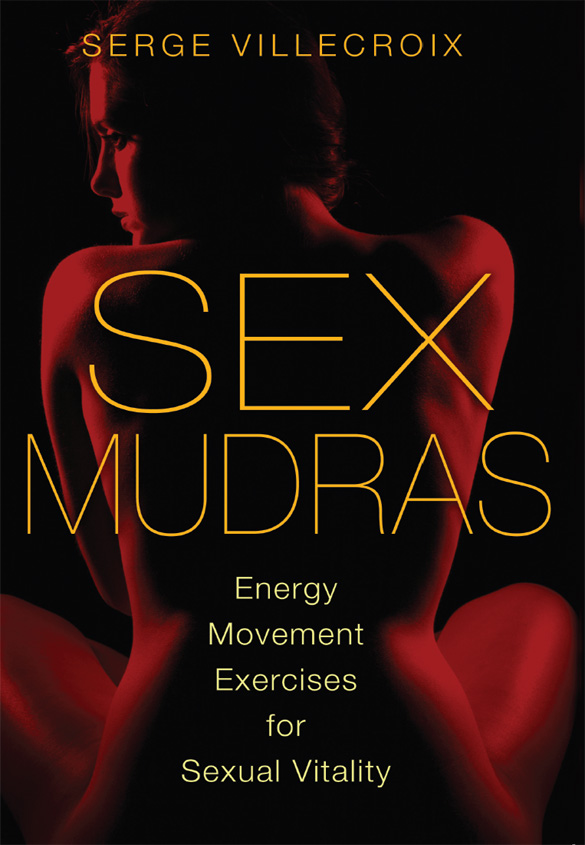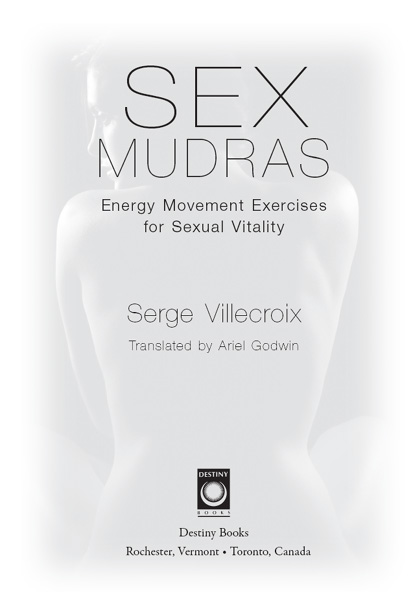Sex Mudras



Â

This book is dedicated to all the lovers
of the world.
Preface
Long ago, on a high Indian plateau, there was a tribe that lived in total self-sufficiency and in peace with the neighboring tribes. Their lives emphasized harmony among all the peopleâparticularly cooperation between spouses. They believed that the greatest cooperation of all was to be found in sexual intimacy, and thus they considered lovemaking one of the noblest arts, on a par with cooking, singing, dancing, and other types of expression.
The chief of the village, an ancient sage, dedicated himself to the intellectual teachings that the masters of various disciplines transmitted to one another. Thus, after the midday mealâusually taken communallyâthe ancient sage directed the work of the field laborers and the artisans as well as other community activities.
When evening came, the sage gathered together the tribe's young adolescents and matched them as couples. They convened in a great bamboo shelter at the center of the village to spend the night there. The beds were separated by simple curtains of palm fronds, giving some privacy to the couples, who were there to practice the refined art of love.
Among the young women and men, the older initiated the younger, putting into practice the lessons they had learned regarding the finer points and exquisite pleasure of fully developed sexuality. Together, they learned everything: female cycles as well as male cycles, impulses, the essential importance of sexual fantasies, sexual positions, pregnancy, and childbirth. Every aspect of sexuality and reproductionâfrom nourishment to the proper behavior of partners toward one anotherâwas included in this initiation. All of this knowledge originated from ayurvedic medicine and had been handed down from generation to generation.
The people of this tribe experienced little jealousy, because each of them had had sex with all the others (both women and men) during the sexual apprenticeship period, which lasted several weeks. For this reason, they had no occasion to indulge later in life in fantasies of switching partners in order to discover something new (an idea that is often a total illusion).
When a young man was in love with a young woman and wished to marry her, he would address his request to the council of sages. The council would then subject him to a certain number of tests. The most remarkable of these tests involved meditating, completely naked, in front of the sages. During this meditation, the young man was required to achieve an erection without any physical stimulation whatsoever and ejaculate purely through the strength of his mental power. This continues to be a part of many yogic practices.
On the wedding dayâafter the young man had passed all the testsâhe would stand before the woman he loved and the sage would say: “Man, here is the woman to whom you are husband!” The master would then turn toward the young woman and say: “Woman, here is the man to whom you are wife!” In saying this, the true meaning was: “You are
her
husband, but she is not
your
wife,” in the sense of possession of property. The same was true reciprocally. When the husband introduced the women he had married, he would say, “Here is the woman to whom I am husband.” The intent of these introductions was simply to make it clear that whenever either spouse gave to the other without ever expecting anything in return, he or she could then feel nothing but surprise and joy upon receiving something completely free. Someone who expects nothing cannot be let down. Disappointment occurs only when one expects something in return, then does not receive it.
Long ago, when someone told me of the existence of this kind of teaching, I began to study ayurvedic, Taoist, and tantric lovemaking practices. Having taught nidra yoga and laya yoga for more than twenty years, I could simply have added these practices to my lessons. I did not do so, however, because I felt that the Western world is not yet ready for such physically direct teaching. Instead, I decided to teach the things that seemed to me most essential for modern couples to learn, so that they might rediscover and apply this lost art in the often frustrating and ephemeral sexual relationships of our present era.
It is not the high numbers of partners or sexual experiences that is to be lamented. Rather, what must be reconsidered is the quality of the relationship, or simply of the sexual act itself and, above all, that act's true reason for taking place. To understand this, it is absolutely necessary to know that certain practices are possible even for us Westerners. Through cooperation and sharing of good “sexual manners,” the relationship will be ennobled and every couple can become more fulfilled.
Introduction
It would be pretentious for any man to boast that he has never experienced a failure of his sexual function. It would be surprising to hear any woman claim that she has never experienced an episode of weakness in her libido. This book is intended to help anyone who is interested in learning simple natural practices to address these and other problems. Pharmaceutical treatmentâthough not without its meritsâis not for everyone and is not discussed in this book.
The era we live in is paradoxical; for several decades now, sexuality has been “liberated” and young people have been discovering their first intimate experiences earlier and earlier. At the same time, however, we are increasingly forgetting how to maintain the sacred connection that is the mutual attraction, and subsequently the sexual union, of two beings. That sacredness comes from nourishing ourselves spiritually, from cultivating the positive energies that are so very necessary for a harmonious life and for meaningful sexuality.
Courses on sexuality are taught at many educational institutions today, and this is an excellent initiative. But should sex be confused with love? People talk about “making love” but are often more reluctant to speak about “having sex” or “being sexual”âas if sex on its own was somehow less worthy. Lack of communication between adolescents and their parents exacerbates these shortcomings of our cultureâonly the most basic biological facts of sex are taught to our young people, who often seem to go about the sexual act merely so that they can tell themselves, “I do it, therefore I am.”
The ancient teachings tell us, however, that thoughtful sacred sexâwith or without romantic “love”âis much more than a simple physiological outlet; it is considered a portal to, and an expression of, the most sacred love, which is universal and accessible to all.
In order for sexuality to blossom, it is necessary to channel it, sometimes even to control it, so that certain energies will come forth to reveal the potential of sacred loveâthe union of two spirits, two souls, and two bodies into one. The partners must pay careful attention to one another in order for their sex life to flourish. Through this transformative experience, a gentle and profound connection will unite the two lovers inseparably, whatever their age and sexes may be.
For all these reasons, this book will be useful both for young people and for those who are older. The exercises, which have been practiced in Asia for millennia, are unusually simple; in order not to make their practice strenuous, it is necessary to meditate upon them slowly, so that the flame of desire may be appropriately channeled and the senses not be excited too frequently. With regular practice of these exercises, the lovers of the worldâto whom this book is dedicatedâwill be certain to observe good effects.
My editor and I hesitated for a long time over an appropriate title for this book. Then, at once, we decided upon the word
mudra
. We liked this term immediately because it is a word used in the West to describe a placement of the hands. Originally a Sanskrit word,
mudra
can be translated as a “seal” or a “sign,” a position of the body, or a symbolic gesture of the hand. This feminine word was used in ancient Buddhism, Tantrism, and traditional dance in India.
Asian peoples regard a mudra as a movement. A sexual mudra, therefore, is simply a gesture or movement used for sex. Sexual mudras are an integral part of ayurvedic medicine. This Indian branch of medicine is as ancient as medical practice itself, with written records dating back to three thousand years ago. Even then, the great masters of the epoch had a great deal of advice to give regarding the possibility of maintaining the best holistic health, in particular by treating certain organs of the body using very specific sexual practices.
This could not be any further removed from the modern, Westernized Kama Sutra; that magnificent teaching has been stripped down, leaving only those few parts that are interesting to Western civilizationânamely the most basic sexual elements. This modern take on the Kama Sutra “in fact bears no resemblance to the original work, which was conceived in chastity and in the deepest contemplation by Vâtsyâyana in his Shaktic text.”
*1
Moreover, Western civilization is not yet ready to learn or practice all of the postures used by the initiates of India. It is necessary to grasp their true resonance before all their subtleties can be appreciated. The Art of Love, as practiced in the Kama Sutra, goes beyond the sexual act to encompass an approach that is as spiritual as it is therapeutic. Hence this present practical guide, in whose pages you will find instructions thatâalthough far from completeâmay be of great interest to the Western mind since it is adapted to that mind's expectations.
Remember, then, that we have different ways of thinking and a different conception of lifeâincluding sexualityâfrom that of the Asian peoples. As generations pass, our worldviews will draw closer together, which is something to be celebrated. But let us advance with care toward our goal; prudence shall be the gauge of our success.
This work contains only exercises involving the reproductive organsâthose directly linked to our sexuality. These exercises may be classified into two types: physical and mental, but the lesson of this book goes much further. The reader will learn to manage, control, tune, and harmonize certain energies, both local and universal, in order to achieve equilibrium for him- or herself and for the two partners together.
Too many people consider sex mostly as a quest for physical pleasure. The fact is, if two partners can meet on three levelsâthe physical, the emotional, and the spiritualâthen they will be on the way to being a happy couple. At the same time, orgasm, the way we view it in Western culture, is not always necessary. However, before reaching these most interesting levels of true realization, we must first develop our physical capabilities and learn to maintain equilibrium.
Often when two people meet and are irresistibly attracted to each other, it is because their emotional and spiritual selves are tuned to the same frequency. Unfortunately, as time passes and the difficulties of modern life intrude, these frequencies may diverge to the point of discord. It order to preserve the sacred bond between partners it is necessary to stay vigilant and to augment sexual practices with certain exercises. Physical intimacy will then bring the partners closer together, and the bonding between them will create a unique and unbreakable link.
My dearest wish as the author is that the reader will make use of this method, and that its mutual practice between partners will help to preserve those essential vibratory frequencies for couples who are well connected, and to restore them for couples who are suffering.